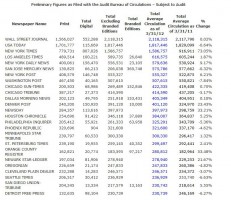
Just two years ago, newspaper publishers were describing circulation drops as avalanches, with year-over-year declines of 8 to 12 percent at many papers, including a nearly 9 percent decline in average daily circulation in 2010 at the Daytona Beach News-Journal. By then, the newspaper industry’s total circulation numbers were down to levels last seen in the 1940s, when the nation’s population was less than half its 2010 level.
The avalanches are over: the bi-annual release of circulation figures by the Audit Bureau of Circulation this morning shows papers finally holding their own, but mostly on the strength of a variety of electronic editions, which have been folded into the larger circulation numbers since last year as one way to staunch print’s losses. Daily circulation increased just under 1 percent. Sunday circulation did better, increasing 5 percent.
The decline, while somewhat slower than in previous years, continued at the News-Journal, however, with average weekday circulation falling to 2.3 percent in the period ending March 31 (compared with the previous year), to 67,560 copies, a loss of 1,643 daily copies. Daily circulation had fallen by 2.1 percent the previous year, and by 10.7 percent the year before that. Sunday circulation fell by 1.5 percent, to 88,194 copies. In March 2011, it had fallen by 3.3 percent over the previous year, and by 8.8 percent over 2009. Overall since 2007, when Sunday circulation was 110,103, the newspaper has seen Sunday circulation fall by 20 percent, and weekday circulation by 25.5 percent.
The average for the six months ending on March 31 is the newspaper’s stronger half of the year, as it reflects snowbird readership. Circulation falls significantly during the late spring to early fall months. Those figures are reported in November. Weekday circulation during those months was 61,000 at the News-Journal.
The News-Journal has yet to make a push for digital editions. Its “digital replica” newspaper, never much highlighted, actually lost subscribers in the past 12 months, dropping from 678 to 495. The St. Augustine Record, in comparison, is using its digital replica to mask severe print circulation losses: its overall daily circulation is at 18,680, but almost a quarter of that is digital. The difference matters to advertisers, who place a smaller value on electronic advertising, while newspapers will combine electronic and print circulation figures to project a stronger presence, even though the two mediums are not quite comparable.

“On average,” ABC reports, “digital circulation now accounts for 14.2 percent of newspapers’ total circulation mix, up from 8.66 percent in March 2011. Digital circulation may be tablet or smartphone apps, PDF replicas, metered or restricted-access websites, or e-reader editions. Branded editions, newspaper-owned products such as commuter, community, alternative-language or Sunday-Select type newspapers, make up 4.5 percent of newspapers’ total average circulation, up from 3.36 percent in March 2011.” The bureau adds: “Due to the many ways that newspapers now distribute and market their content — metered paywalls, mobile apps, bundled subscriptions, branded editions — ABC cautions against drawing too many direct comparisons of the data.”
The Daytona Beach News-Journal is owned by Halifax Media, until last year a small operation with only the News-Journal for a recognizable brand. In late December, Halifax Media bought the New York Times Regional Group’s 16 regional newspapers, including five in Florida. There’s been talk of Halifax Media buying an additional chain (Freedom papers).
A chart listing all of Florida’s major newspapers’ March circulation figures, going back to 2008, will post here shortly.




























David says
I have no ideal why anybody would read on use the newspaper, when all your news, or business can be done on your lap top, cell phone, or I pod. Newspapers are such a dinosaur.
ric says
I see a buy out of the Observer and if you want to continue to receive the Observer you will have to subscribe to the Journal.
B. Claire says
First had to go through terrible withdrawal pains when it was no longer The Washington Post out in the driveway. God what a great newspaper!
Made do with DBNJ. Then after the new right wing management took over the DBNJ, appreciated the old DBNJ a lot more.
Love & miss REAL, actual paper, newspapers here …where Guns & Ammo probably #1 reading source…and Beck, Rush & FOX as the scary, non-funny fake news disseminators.
Some very good Palm Coast news sources…so thank heaven for them…enjoy them a lot. Kudos to them.
On step three of my 12-step program to adapt to online ‘news’…but it will never be the same.
Sally says
To B. Claire: cancelled the “new’ DBNJ when it went right and now I get the New York Times in my driveway! Nirvana!
elaygee says
My bird won’t even use it anymore as it keeps drifting off the right edge of the cage bottom.
B. Claire says
Sally… ‘Nirvana’ is right !
elaygee… smart bird :)
Thnx for the ‘how others are making it through sans fav newspaper’ testimonials.
palmcoaster says
It is more enjoyable to seat back and relax while reading a “good ole’ news paper print”! Otherwise ask the patriarch of the household. Who can read a computer monitor, wether lap top or desk top underneath the shade of an oak in the garden or by the cool breeze on the dock, or while enjoying the beach with daylight glare and without power connections nearby. Could anyone imagine an over 60 years old using his/her phone gadget to read Flagler Live or any other editorials NYT or WP, on the above mentioned settings? Only the comfort of the newspaper or magazine print, afford us that freedom away from closing ourselves in our home offices away from the wondrous outdoors, to read about what is going on. My personal view…
David says
Palm Coaster: FYI. Most of today laptops, I Pads, cell phones are small enough to be carried in the palm of your hand, and a charge capability to last up to a 9 to 12 hours, with sun screening. My parents are both in their late 60’s and they are computer literate and go everywhere with their devices. My personal view.
I don't think so says
Electronic devices are too small to read the newspaper. Someone may be able to read an article, but so much is missed when trying to read the entier paper from an electronic device. Besides what would we do without sale ads and coupons?
As years pass, most folks will be blind from reading from electronic devices, if they don’t have cancer first.
David says
I don’t think so says. Actually you get more info by reading the news on line because you can google what you have read, and get more about the story, the context behind the story, and info are the author. As far as ads and coupons, you can go to any major food chain or department stores and get more coupons and ads than you can out of the newspaper. You can even be put on their E mail list where their will send coupons of upcoming sales. SAVE A TREE.
David says
Read your newspaper and magazines on line. SAVE A TREE.
FlaglerResident says
Anyone can read underneath the shade of an oak, or on a dock, or on a beach, or anywhere! It’s called a Kindle Fire and we do it daily! Glare is not an issue with this device, and many others. You don’t need power connections. Oh, and I am over 60. In the days when there were no newspapers would you be saying no newspaper is needed, we have each others gossip? I keep up with the news at least twice per day in the wonderful outdoors on a Kindle Fire!
FlaglerResident says
Additionally, as I typed the comment above and this one I am in my backyard in the wonderful outdoors, smelling the rose bushes, enjoying the magnolias in bloom, watching the ducks on the pond, seeing a cardinal in my birdbath, and enjoying the squirrels eat the bird food while the mocking birds try to attack them, all from a Kindle Fire with no glare, and no electrical connection! Thank goodness for technology that keeps you connected to anything and anywhere in the world! A newspaper sure can’t do that and is old news by the time the paper version is in your driveway.
B. Claire says
palmcoaster….
yes sir ee…. this is how us oldies use the internet machine…
palmcoaster says
@David you have a very good point regarding our trees. Also you have very cool parents that adapted to the gadget age. Lucky you!